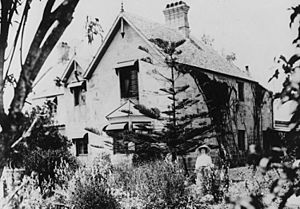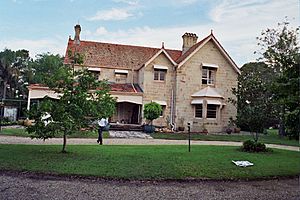Bulimba House facts for kids
Quick facts for kids Bulimba House |
|
|---|---|

Residence in 2015
|
|
| Location | 34 Kenbury Street, Bulimba, Queensland, Australia |
| Design period | 1840s - 1860s (mid-19th century) |
| Built | 1849-1850 |
| Architect | Andrew Petrie |
| Official name: Bulimba House, Toogoolawah | |
| Type | state heritage (built, landscape) |
| Designated | 21 October 1992 |
| Reference no. | 600179 |
| Significant period | 1849- |
| Significant components | garden/grounds, flagpole/flagstaff, residential accommodation - main house, carriage way/drive |
| Builders | Andrew Petrie |
| Lua error in Module:Location_map at line 420: attempt to index field 'wikibase' (a nil value). | |
Bulimba House is a special old house located at 34 Kenbury Street in Bulimba, Queensland, Australia. It was designed and built by Andrew Petrie between 1849 and 1850. This house is also known as Toogoolawah. It was added to the Queensland Heritage Register on 21 October 1992. This means it's a very important historical place.
History of Bulimba House
Bulimba House was built in 1849-1850 for early Queensland landowners, David and Mary McConnel. David had started a large farm called Cressbrook in the Brisbane Valley in 1841. This was one of the first big farms in the Moreton Bay area, which was part of New South Wales back then.
In mid-1849, David McConnel bought about 173 acres of land. This land was located along a bend in the Brisbane River, about five miles downstream from Brisbane Town. The local Aboriginal people called this rainforest area Tugulawa or Toogoolawah. This name meant "shape of heart." Here, McConnel started an experimental farm. He wanted to show that growing crops for sale could work well in Moreton Bay. Some of the first crops he tried were cotton, wheat, barley, and corn.
While living nearby, McConnel hired a builder named Andrew Petrie. Petrie was asked to construct the house at Toogoolawah. It became the first stone house in the Brisbane area built in the Tudor style. The stone came from a place on the Brisbane River called Quarries Reach. Special wood called Moreton Bay cedar was used for the house's structure and inside finishes. A cabinetmaker named Robert Towell made most of the furniture right there, using local cedar wood.
David and Mary McConnel moved to Toogoolawah in December 1849. They lived in a smaller building first, until the main house was finished. By 1852, they started using the Aboriginal name "Bulimba" for the area. This name meant "place of the magpie lark" or "peewee."
Bulimba House was built on a small hill in the middle of the property. From every window, you could see amazing views of the whole estate. It was the main building of a "model manorial farm." This farm grew crops and also had its own dairy cows, many other animals, a kitchen garden, and a large fruit orchard. It was almost completely self-sufficient.
By 1853, the farm had grown to 220 acres. It included many other buildings like a kitchen, laundry, stables, and workers' cottages. In the early years, about 80 to 100 men worked on the estate. Some of these workers were probably seasonal, meaning they only worked during certain times of the year. Their wives and daughters also helped in the house and dairy.
Following an old tradition, McConnel encouraged his workers to start their own farms. He sold them small parts of the Bulimba property. The workers would pay him back regularly from their wages. They were also given time off to clear their land and plant crops.
In February 1853, due to Mary McConnel's poor health, the property was sold for £5,000. It was bought by another landowner named Donald Coutts. The McConnels then went back to Britain for a while. Most of their furniture was sold at this time too.
Donald Coutts later divided the estate into smaller pieces of land. But he continued to live in the house until he passed away in 1869. Since then, many important people from Brisbane have owned or rented the house. This includes Arthur Edward Moore, who was the Premier of Queensland from 1929 to 1932. He bought Bulimba House in 1935. Today, the property is still a family home, but it's on a much smaller piece of land, about 0.65 hectares. During the 1970s, the owners at that time added large sections to the back of the house and changed some parts inside. The old wooden kitchen and service wing were taken down. The current owners have done a lot of work to preserve the house and have updated the kitchen.
What Bulimba House Looks Like
Bulimba House is a beautiful two-story house made of sandstone and brick. It sits on a gently sloping hill and is surrounded by a garden with old, tall trees. The house and its setting make Bulimba look very pretty. Bulimba House has a roof that slopes steeply and is covered with terracotta tiles. Tall chimneys rise above the roof. The house has a simple L-shape. The front (north) side has two parts that stick out, with pointed roofs, and a wide porch on the ground floor with a terracotta-tiled roof. The back of the house (south side) also has a wide porch on the ground floor, with an enclosed porch above it.
The outside of the house has simple details. The north, west, and east sides are made of sandstone blocks. The south side is made of brick. The roof tiles, which were added around 1919, even have small turtle designs on them! The front of the house has single windows in the pointed roof sections. There is also a window that sticks out on the ground floor. The windows have curved metal covers with heart-shaped designs, which were added later. The parts of the roof that stick out have deep wooden edges and terracotta decorations. The porch is held up by octagonal wooden posts with rounded tops. The porch ceiling is made of wood.
The south porch also has octagonal wooden posts. The ends of the house are simpler, with only three openings on the west side. On the east side, there is a small room under the sloping roof with a pointed roof above it.
The inside of the house has some lovely details. It has cedar and hoop pine wood throughout. The main entrance hall has cedar stairs with a beautifully carved railing. There's a fancy archway at the bottom of the stairs. The Dining Room has a deep plaster border where the walls meet the ceiling. It also has a fireplace with a finely carved mantelpiece and tiled iron decorations. This room also has a window that sticks out, set into an arched space. This window has sliding wooden shutters inside that can be hidden in wooden panels under the windowsill. The Drawing Room has a special border on the ceiling and deep wooden baseboards. It has an iron and tiled fireplace with a marble mantelpiece. This room also has wooden shutters and double wooden doors that open onto the porches.
The rooms upstairs have sloped ceilings. They also have fireplaces with wooden and marble mantelpieces.
The gardens around the house have a circular driveway, a wooden flagpole, and several old trees. These include mango trees, camphor laurels, and jacarandas, which are known for their beautiful purple flowers.
Why Bulimba House is a Heritage Site
Bulimba House was listed on the Queensland Heritage Register on 21 October 1992. This means it is recognized as an important historical place for several reasons:
- It shows how Queensland's history developed. Bulimba House is important because it was the center of one of Brisbane's first experimental farms along the river. It also played a big part in how Bulimba grew as a farming community in the 1850s.
- It shows rare or uncommon parts of Queensland's history. This house is special because it's one of the few old sandstone homes still standing in Brisbane. It also shows the amazing skills of Brisbane's early Scottish carpenters and stonemasons.
- It shows the main features of its type of historical place. The house is a beautiful, well-designed building with some very detailed parts inside. Its setting in the garden makes the Bulimba area look very charming and historic.
- It is important for its beauty. The house is a fine, detailed building. With its garden, it makes the Bulimba area look very picturesque and adds to its beauty.



